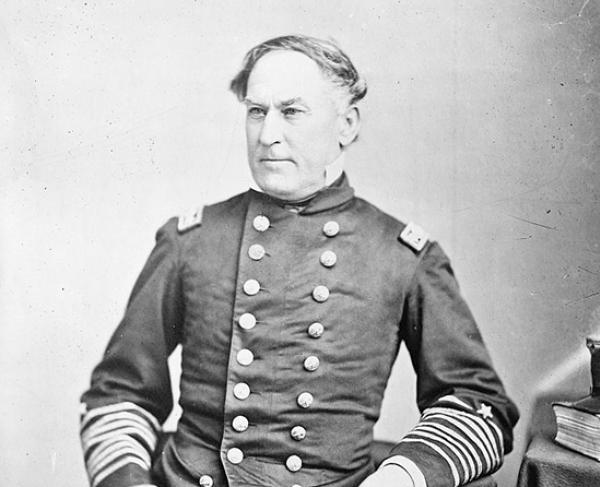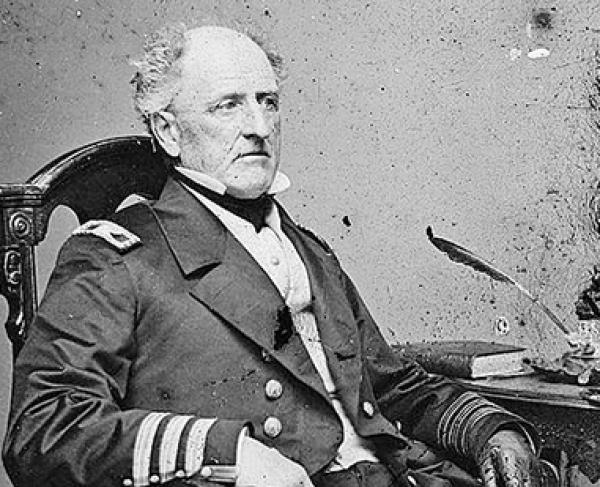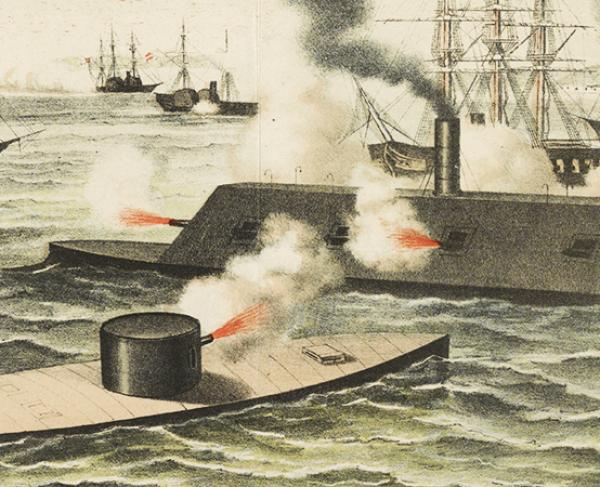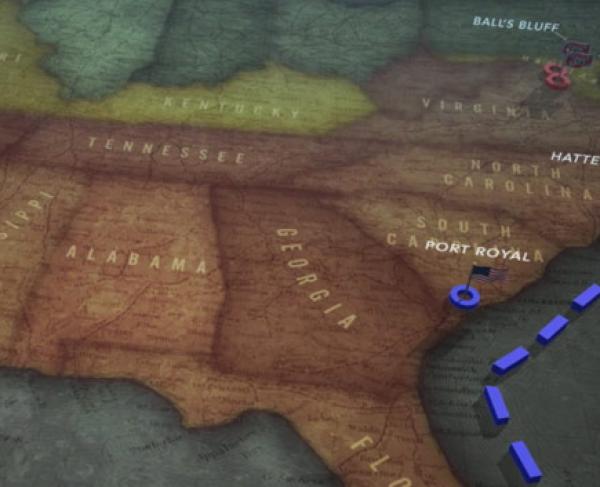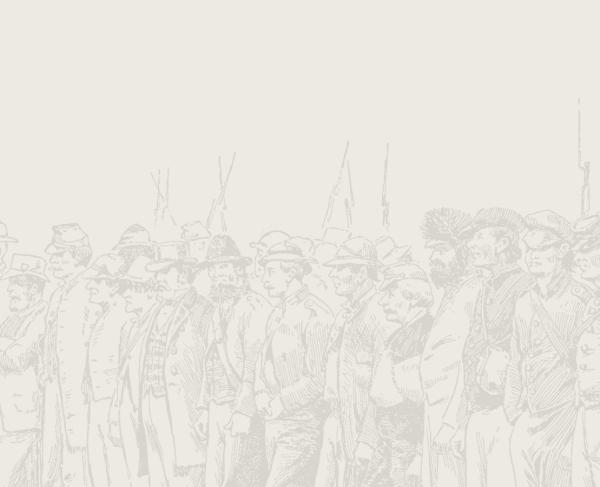
Mobile Bay
Mobile and Baldwin County, AL | Aug 2 - 23, 1864
In the early fall of 1864, Admiral David Farragut’s fleet attacked one of the last open Confederate ports. After one of his ships hit a torpedo in the bay, Admiral Farragut famously said, “ Damn the Torpedoes, full speed ahead.” Several hours later, his fleet defeated the Confederate fleet and secured the bay.
How It Ended
Union victory. After hours of intense fighting, the Confederate naval forces under Admiral Franklin Buchanan were defeated by Admiral David G. Farragut's fleet, closing Mobile as an open port and assisting in the re-election of President Abraham Lincoln.
In Context
Mobile Bay was one of the last open Confederate ports. Its defenses included a series of forts, mines, and obstructions, making it hard for any Federal force to attack the bay. By 1864, David Farragut was tasked with capturing the bay and closing the port. During his preparations, Admiral Farragut assembled a joint Army and Naval force. Operations began on August 2, 1864, and lasted till August 23rd. After taking Fort Gaines on Dauphin Island and Fort Morgan on Mobile Point, Union forces cut off Mobile from open trade.
Mobile Bay had two main ship channels defended by three forts. The largest, Fort Morgan, a 46-gun, star-shaped fortification built in 1834, protected the deepest channel from its eastern side. On the west side of the channel, the smaller and newer Fort Gaines provided covering fire with 26 guns on Dauphin Island, and Fort Powell guarded Grant’s Pass at the western entrance of Mobile Bay with 16 guns.
The Confederates blocked part of the main channel with torpedoes (floating wooden barrels of explosives like modern naval mines) to supplement these defenses. Accordingly, they assembled a small flotilla consisting of the ironclad CSS Tennessee and three gunboats inside the bay. They were commanded by the veteran Admiral Franklin Buchanan, who led the ironclad CSS Virginia at the Battle of Hampton Roads two years earlier.
Rear Admiral David G. Farragut received the assignment of capturing Mobile. Responsible for leading an army assault in conjunction with Farragut’s attack was Maj. Gen. Gordon Granger with about 1,500 men.
Granger landed on Dauphin Island on August 3 and laid siege to Fort Gaines while Farragut assembled his fleet of four ironclad monitors and more than a dozen wooden ships. Finally, early on August 5, 1864, the Federal fleet passed into the harbor.
Farragut split his ships into two parallel columns: the ironclads sailing nearest Fort Morgan and the wooden ships on the far side. Farragut ordered the larger wooden ships lashed together to a smaller ship so that the bigger vessels could serve as shields and so the ships would be able to tow each other if one became disabled. Farragut personally observed much of the battle while lashed to the rigging of his flagship, the USS Hartford.
The ships steamed through the narrow width of the channel that had not been mined while passing under the fort's guns. But, as the columns maneuvered, the ships found themselves drifting into the edge of the minefield. The ironclad USS Tecumseh struck a torpedo and sank almost instantly, and cautious Union captains began stopping their ships while still within range of Fort Morgan. At this juncture, Farragut ordered Hartford forward with the famous line, "Damn the torpedoes! Full speed ahead!"
Although facing bombardment from the forts and the Confederate ships, Hartford made it through the minefield in one piece, with the rest of the fleet following in its wake. Once into the expansive bay, the fleet could quickly move out of range of Fort Morgan’s guns, leaving only the Confederate ships to contend with. The Federals promptly captured or drove away from the Rebel gunboats Selma, Gaines, and Morgan. Still, despite the overwhelming odds, the CSS Tennessee, Buchanan’s flagship, moved forward to meet the Northerners.
Buchanan was soon surrounded by the Union ironclads as he steered for the Hartford, but CSS Tennessee’s armored plating protected her as she was rammed and pounded with shot. The ship’s weak engine – a product of the Confederacy’s limited industrial capacity – made her too slow to outmaneuver her adversaries and prevented her from successfully ramming any Union ships. Instead, the ships fought at close quarters; Tennessee slid alongside Hartford’s side at an arm’s length as their crews fired their guns at point-blank range.
Eventually, Tennessee’s slow engine, bad gunpowder, and fewer guns took their toll. Buchanan was injured, and the ship’s rudder chains were shot away, preventing her from steering and allowing the Federals to pummel the ironclad. Three hours after the fighting started, the CSS Tennessee surrendered, leaving the bay in Union control and closing the port to Southern blockade runners.
322
1,500
Without resupply or reinforcements, Fort Gaines surrendered on August 8th, and Fort Morgan fell on August 23th.
The Union suffered over 300 casualties in the fighting compared to less than 50 for the Confederates, although when the forts surrendered, some 1,500 Southerners were captured. The city of Mobile fell to a Union army expedition eight months later, on April 12, 1865, after the capture of Spanish Fort, on April 8th and Fort Blakeley on April 9th at the northern end of the bay. Farragut's victory at Mobile Bay was one of the badly needed Union victories along with Atlanta and Cedar Creek in late 1864 that ensured President Abraham Lincoln's reelection in November.
Admiral Farragut's main objective was to capture the Bay, not the city in order to cut the city from the open seas. This campaign was part of a much greater effort in what was known as the Anaconda Plan to cut off all the south's ports from trade. Farragut’s entire force, over 5,000 strong, thus could not and did not intend to capture the heavily defended city and hold it. The city fell only eight months later, on April 12, 1865.
In the tumultuous year of 1864, a lot was riding for the Union cause. Many in the North were beginning to tire of the costly war and the rising death toll. In addition, it was also a Presidential election year , in which many felt Lincoln would not be re-elected. President Lincoln ran on the platform to see the war through, and Union General Geroge B. McClellan ran to end the war at once. Lincoln was re-elected due to a string of Union victories at Atlanta, Cedar Creek, and Mobile Bay.
Mobile Bay: Featured Resources
All battles of the Operations in Mobile Bay Campaign
Related Battles
5,500
1,500
322
1,500
